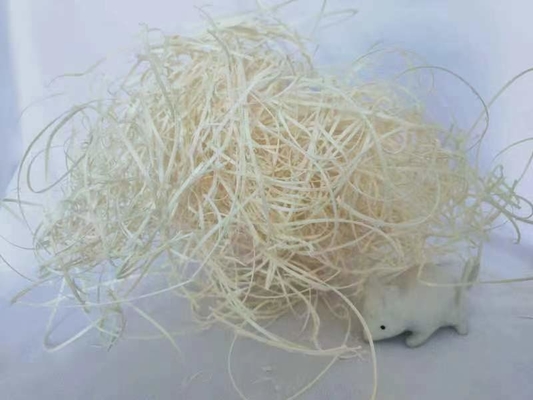

Wood wool, also known as wood excelsior or wood shavings, is a versatile material made from thin slivers of wood. It is commonly used in various applications due to its unique properties. Wood wool is produced by machine shredding or cutting wood into thin strands, resulting in a fibrous and absorbent material.
Packaging: Wood wool is often used as a packaging material due to its cushioning and shock-absorbing properties. It provides excellent protection for fragile items during shipping and transportation. It is commonly used to pack delicate products like glassware, ceramics, or electronic components.
Horticulture and Gardening: Wood wool is utilized in horticulture and gardening as a mulch or growing medium. It helps retain moisture in the soil, promotes healthy root growth, and provides insulation for plants. Wood wool can also be used for hydroponic gardening and as a substrate for growing mushrooms.
Animal Bedding: Wood wool is a popular choice for animal bedding, particularly for small animals like rodents, rabbits, or birds. It offers a soft and comfortable surface for them to rest and burrow. Wood wool has excellent absorbent properties, helping to control odors and maintain a clean and hygienic environment for the animals.
Arts and Crafts: Wood wool is used in various arts and crafts projects. It can be shaped, dyed, and glued to create textured surfaces or decorative elements. Wood wool is commonly utilized in gift baskets, floral arrangements, and festive decorations.
Fire Starters: Wood wool is highly flammable and is often used as a natural fire starter. It easily catches fire and burns slowly, making it an excellent option for starting fires in fireplaces, wood stoves, or camping situations.
Insulation: Wood wool can be used as insulation material in construction or for soundproofing purposes. It provides thermal insulation and helps regulate temperature in buildings. Wood wool panels or boards are installed in walls, ceilings, or floors to improve insulation efficiency.
Wood wool offers several advantages, including its natural and biodegradable nature, moisture absorption capabilities, and versatility in various applications. However, it's important to ensure that the wood used for wood wool is sourced sustainably and free from chemicals or treatments that could be harmful to humans, animals, or the environment.
Excellent Absorbency: Wood wool has high absorbent properties, making it ideal for applications where moisture control is important. It can absorb and retain liquids, such as water or oils, effectively. This makes it useful in packaging, animal bedding, and horticultural applications where moisture management is essential.
Cushioning and Shock Absorption: Wood wool provides excellent cushioning and shock absorption properties. It can protect delicate or fragile items during shipping and transportation, reducing the risk of damage. Its ability to cushion impacts makes it a popular choice for packaging fragile goods like glassware, electronics, or ceramics.
Natural and Biodegradable: Wood wool is an environmentally friendly material as it is made from natural wood fibers and is biodegradable. It decomposes naturally over time, reducing waste and environmental impact. It is a sustainable alternative to synthetic packaging materials, contributing to a greener and more sustainable approach.
Insulation and Thermal Properties: Wood wool has inherent insulation properties. It helps regulate temperature and provides thermal insulation in applications such as construction or soundproofing. Wood wool panels or boards can be used to improve insulation efficiency in walls, ceilings, or floors, enhancing energy efficiency and comfort.
Versatility and Adaptability: Wood wool is a versatile material that can be easily manipulated and adapted to various applications. It can be cut, shaped, or compressed to fit specific requirements. Its flexibility allows for easy customization and integration into different products and designs.
Fire Resistance: Wood wool has inherent fire-resistant properties. It is difficult to ignite and burns slowly, making it a safer material in fire-prone environments. Wood wool can be used as a natural fire starter due to its flammability, making it a handy option for camping or starting fires in controlled settings.
Natural Aesthetics: Wood wool has a natural and rustic appearance, which adds aesthetic value to applications such as gift baskets, floral arrangements, or arts and crafts projects. Its texture and visual appeal make it a popular choice for decorative purposes.
Cost-Effective: Wood wool is often cost-effective compared to alternative materials. It is readily available and can be produced from wood waste or by-products, reducing production costs. Its affordability makes it a practical choice for applications where cost efficiency is important.
While wood wool offers numerous advantages, it's important to consider specific requirements and suitability for each application. Certain factors such as wood quality, treatment, and sourcing should be taken into account to ensure the safety and suitability of wood wool in the intended use.